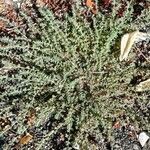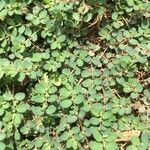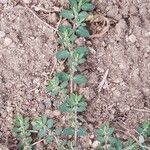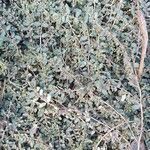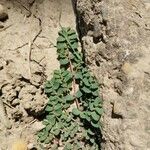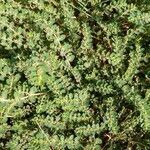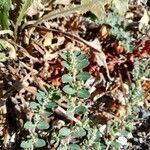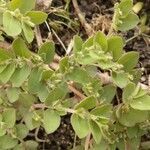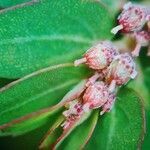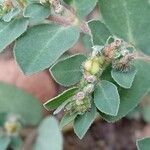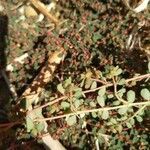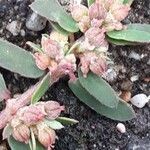Prostrate much-branched annual herb, with branches to 20 cm. long, glabrous on the underside, pilose above with short curled hairs, the whole plant often tinged purplish.. Leaves ovate, to 8 × 5 mm, base obliquely rounded, apex rounded, margin obscurely toothed, upper surface glabrous, lower surface sparsely pilose towards the apex; petiole to 1 mm. long; stipules pilose, free on the upper surface of the branch, triangular, 0.5 mm. long, joined on the lower surface to form a broad triangle to 1 mm. long with 2 unequal teeth.. Cyathia solitary on peduncles 1.25 mm. long, terminal and pseudoaxillary on short leafy shoots, 1 × 0.6 mm, with barrel-shaped involucres; glands 4, minute, red, with minute white or pink appendages; lobes minute, triangular, pilose.. Male flowers few: bracteoles hair-like; stamens 1 mm. long.. Female flower: ovary pedicellate; styles 0.2 mm. long, spreading, bifid to the base.. Capsule exserted on a reflexed pilose pedicel 1.5 mm. long, acutely 3-lobed, with truncate base, 1.25 × 1.25 mm, the base and purple-tinged sutures beset with long spreading hairs.. Seeds oblong-conical, acutely 4-angled, 1 × 0.5 mm, grey-brown, with numerous distinct transverse ridges and grooves.. Fig. 78/2, p. 422.
Herbs, annual, 15-19 cm tall. Root fibrous. Stems many from base, prostrate, usually light red or red, occasionally green or yellow-green, glabrous or sparsely pubescent. Leaves opposite; stipules long triangular, easily fallen; petiole very short or sessile; leaf blade elliptic to obovate, 3-7(-8) × 2-4(-5) mm, adaxially green, sometimes with light red or red abaxially, margin entire or irregularly finely serrulate, apex rounded. Cyathia single, axillary or few clustered, peduncle 2-3 mm; involucre turbinate, ca. 1 × 1 mm, usually glabrous, sometimes with some pubescence, marginal lobes 5, triangular or rounded; glands 4, appendages white, extremely narrow. Male flowers many, usually shorter than cup. Female flower pedicellate, exserted from involucre; ovary sparsely pubescent on angles; styles nearly connate at base; stigma 2-lobed. Capsule 3-angular, ca. 1.5 × 1.4 mm, smooth, glabrous except for white hairs along angles. Seeds ovoid-tetragonal, ca. 0.9 × 0.5 mm, yellow, each side with 6 or 7 transverse furrows; caruncle absent. Fl. and fr. Apr-Oct.
Bisexual, sparsely pubescent, annual herb, up to 0.2 m in diam. from slender rootstock. Leaves 3-7 x 1-4 mm, toothed, glabrous to sparsely hairy beneath, ciliate, shortly petiolate, stipules on upper side of stem free, below fused, deltoid-ovate and apically toothed. Cyathia on short axillary leafy branches with 1 cyathium per pair of leaves, ± 1 mm in diam., sometimes thinly pubescent; glands 4, appendages small or obsolete. Flowering time Nov.-Feb. Capsule 1.0-1.5 mm in diam., pubescent along angles, exserted.
Annual herb. Stems always procumbent, puberulous on upper side, at least along a middle line, glabrous on lower side, often tinged purplish. Leaves opposite, shortly petiolate; blade oblong to elliptic, apex obtuse or rounded, margins distinctly or obscurely toothed; stipules on lower side united, deltoid-ovate. Flowers: solitary or in terminal inflorescences; green; Nov.-Apr. Fruit a capsule, with a row of hairs along each suture.
Leaves with a petiole to 1 mm long; stipules free on the upper surface of the branch, 0.5 mm long, triangular, pilose, joined on the lower surface to 1 mm long, forming a broad triangle with 2 unequal teeth; lamina to 8 × 5 mm, ovate, rounded at the apex, obliquely rounded at the base, obscurely toothed at the margin, upper surface glabrous, lower surface sparsely pilose towards the apex.
Much like no. 31 [Euphorbia maculata L.], but with the lvs more variable in outline, chiefly less than 1 cm, with the styles bifid to the base or nearly so, and with the sharply quadrangular seeds marked with 3 or 4 conspicuous transverse ridges, is rarely adventive (from s. U.S.) and probably not persistent in our range. (E. chamaesyce, misapplied)
Cyathia terminal and pseudoaxillary on short leafy shoots, solitary on peduncles to 1.25 mm long, 1 × 0.6 mm, with barrel-shaped involucres; glands 4, minute, red, with minute white or pink appendages; lobes minute, triangular, pilose.
Capsule exserted on a reflexed pilose pedicel 1.5 mm long, 1.25 × 1.25 mm, acutely 3-lobed with a truncate base; the base and purple-tinged sutures beset with long spreading hairs.
Prostrate, annual herb, glabrous on underside, pilose above, often tinged purplish. Leaves ovate, up to 8 x 5 mm. Capsule with a row of hairs along each suture. Flowers green.
Prostrate much-branched annual herb, the whole plant often tinged purplish; branches to 20 cm long, glabrous on the underside, pilose above with short curled hairs.
Seeds 1 × 0.5 mm, oblong-conical, acutely 4-angled, with numerous distinct transverse ridges and grooves, greyish-brown.
Female flower: ovary pedicellate; styles 0.2 mm long, spreading, bifid to the base.
Male flowers few: bracteoles hair-like; stamens 1 mm long.
Stems slender 2–8 in. long radiating from the tough root
A prostrate spreading herb
A herb.
